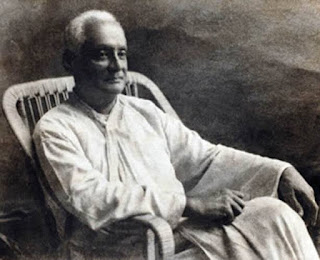Painter Gaganendranath Tagore was born in the year 1867, on this day, so, today is the154th birthday of this eminent painter of Jorasanko Thakur Bari. He was died on 14 February, 1938.
Gaganendranath Tagore was born at Jorasanko into a family whose creativity defined Bengal's cultural life. Gaganendranath was the eldest son of Gunendranath Tagore, grandson of Girindranath Tagore and a great-grandson of Prince Dwarkanath Tagore. His brother Abanindranath was a pioneer and leading exponent of the Bengal School of Art. He was a nephew of the poet Rabindranath Tagore and the paternal great-grandfather of actress Sharmila Tagore.
Gaganendranath received no formal education but trained under the watercolourist Harinarayan Bandopadhyay. In 1907, along with his brother Abanindranath, he founded the Indian Society of Oriental Art which later published the influential journal Rupam. Between 1906 and 1910, the artist studied and assimilated Japanese brush techniques and the influence of Far Eastern art into his own work, as demonstrated by his illustrations for Rabindranath Tagore's autobiography Jeevansmriti (1912). He went on to develop his own approach in his Chaitanya and Pilgrim series. Gaganendranath eventually abandoned the revivalism of the Bengal School and took up caricature. The Modern Review published many of his cartoons in 1917. From 1917 onwards, his satirical lithographs appeared in a series of books, including Play of Opposites, Realm of the Absurd and Reform Screams.
Between 1920 and 1925, Gaganendranath pioneered experiments in modernist painting.Partha Mitter describes him as "the only Indian painter before the 1940s who made use of the language and syntax of Cubism in his painting".From 1925 onwards, the artist developed a complex post-cubist style.
Gaganendranath also took a keen interest in theatre, and wrote a children's book in the manner of Lewis Carroll, Bhodor Bahadur ('Otter the Great').
Works
- Adbhut Lok: realm of the absurd, 1917, Calcutta: Vichitra Press, a portfolio of thirteen satirical pictures.
- Naba Hullod: Reform screams; a pictorial review at the close of the year 1921, 1921, Calcutta: Thacker, Spink & Co.
- Birupa bajra (Play of Opposites), 1930, Calcutta: Preonath Das Gupta for the Indian Publishing House.
- Bhondor bahadur, Kolkata: Shishu Sahitya Samsad, 1998, classic children's book

Comments